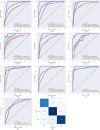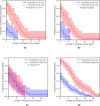Deep COVID DeteCT: an international experience on COVID-19 lung detection and prognosis using chest CT
- PMID: 33514852
- PMCID: PMC7846563
- DOI: 10.1038/s41746-020-00369-1
Deep COVID DeteCT: an international experience on COVID-19 lung detection and prognosis using chest CT
Abstract
The Coronavirus disease 2019 (COVID-19) presents open questions in how we clinically diagnose and assess disease course. Recently, chest computed tomography (CT) has shown utility for COVID-19 diagnosis. In this study, we developed Deep COVID DeteCT (DCD), a deep learning convolutional neural network (CNN) that uses the entire chest CT volume to automatically predict COVID-19 (COVID+) from non-COVID-19 (COVID-) pneumonia and normal controls. We discuss training strategies and differences in performance across 13 international institutions and 8 countries. The inclusion of non-China sites in training significantly improved classification performance with area under the curve (AUCs) and accuracies above 0.8 on most test sites. Furthermore, using available follow-up scans, we investigate methods to track patient disease course and predict prognosis.
Conflict of interest statement
The authors declare no competing interests.
Figures













References
LinkOut - more resources
Full Text Sources
Other Literature Sources

